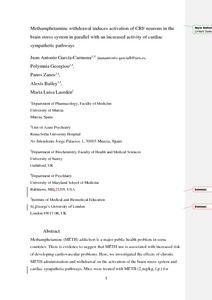García-Carmona, JA; Georgiou, P; Zanos, P; Bailey, A; Laorden, ML
(2018)
Methamphetamine withdrawal induces activation of CRF neurons in the brain stress system in parallel with an increased activity of cardiac sympathetic pathways.
Naunyn Schmiedebergs Arch Pharmacol, 391 (4).
pp. 423-434.
ISSN 1432-1912
https://doi.org/10.1007/s00210-018-1470-z
SGUL Authors: Bailey, Alexis
![[img]](https://openaccess.sgul.ac.uk/109638/1.hassmallThumbnailVersion/Final%20accepted.pdf)  Preview |
|
PDF
Accepted Version
Available under License ["licenses_description_publisher" not defined].
Download (1MB)
| Preview
|
Abstract
Methamphetamine (METH) addiction is a major public health problem in some countries. There is evidence to suggest that METH use is associated with increased risk of developing cardiovascular problems. Here, we investigated the effects of chronic METH administration and withdrawal on the activation of the brain stress system and cardiac sympathetic pathways. Mice were treated with METH (2 mg/kg, i.p.) for 10 days and left to spontaneous withdraw for 7 days. The number of corticotrophin-releasing factor (CRF), c-Fos, and CRF/c-Fos neurons was measured by immunohistochemistry in the paraventricular nucleus of the hypothalamus (PVN) and the oval region of the bed nucleus of stria terminalis (ovBNST), two regions associated with cardiac sympathetic control. In parallel, levels of catechol-o-methyl-transferase (COMT), tyrosine hydroxylase (TH), and heat shock protein 27 (Hsp27) were measured in the heart. In the brain, chronic-METH treatment enhanced the number of c-Fos neurons and the CRF neurons with c-Fos signal (CRF+/c-Fos+) in PVN and ovBNST. METH withdrawal increased the number of CRF+neurons. In the heart, METH administration induced an increase in soluble (S)-COMT and membrane-bound (MB)-COMT without changes in phospho (p)-TH, Hsp27, or pHsp27. Similarly, METH withdrawal increased the expression of S- and MB-COMT. In contrast to chronic treatment, METH withdrawal enhanced levels of (p)TH and (p)Hsp27 in the heart. Overall, our results demonstrate that chronic METH administration and withdrawal activate the brain CRF systems associated with the heart sympathetic control and point towards a METH withdrawal induced activation of sympathetic pathways in the heart. Our findings provide further insight in the mechanism underlining the cardiovascular risk associated with METH use and proposes targets for its treatment.
| Item Type: |
Article
|
| Additional Information: |
This is a post-peer-review, pre-copyedit version of an article published in Naunyn-Schmiedeberg's Archives of Pharmacology. The final authenticated version is available online at: http://dx.doi.org/10.1007/s00210-018-1470-z |
| Keywords: |
Addiction, COMT, CRF, Heart, Hsp27, Methamphetamine, Withdrawal, Addiction, COMT, CRF, Heart, Hsp27, Methamphetamine, Withdrawal, Pharmacology & Pharmacy, 1115 Pharmacology And Pharmaceutical Sciences |
| SGUL Research Institute / Research Centre: |
Academic Structure > Institute of Medical & Biomedical Education (IMBE)
Academic Structure > Institute of Medical & Biomedical Education (IMBE) > Centre for Biomedical Education (INMEBE) |
| Journal or Publication Title: |
Naunyn Schmiedebergs Arch Pharmacol |
| ISSN: |
1432-1912 |
| Language: |
eng |
| Dates: |
| Date | Event |
|---|
| April 2018 | Published | | 30 January 2018 | Published Online | | 18 January 2018 | Accepted |
|
| Publisher License: |
Publisher's own licence |
| Projects: |
|
| PubMed ID: |
29383398 |
 |
Go to PubMed abstract |
| URI: |
https://openaccess.sgul.ac.uk/id/eprint/109638 |
| Publisher's version: |
https://doi.org/10.1007/s00210-018-1470-z |
Statistics
Item downloaded times since 27 Feb 2018.
Actions (login required)
 |
Edit Item |



